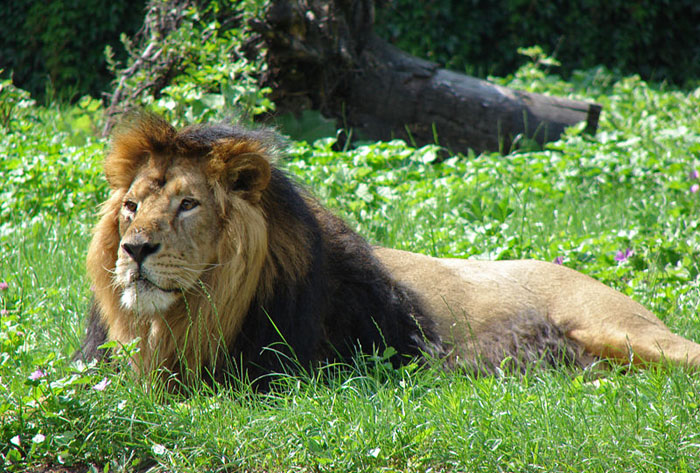See below for exciting update!
In SN 7.10, a brahmin is lamenting his ill luck, by comparison with the unencumbered freedom of the Buddha. The Buddha responds by agreeing point by point that he is, in fact, unencumbered by these things, at which the brahmin goes forth.
Most of these encumbrances are quite understandable: lost oxen, ruined crops, barns where the rats “dance merrily” (in Ven Bodhis’ delightful rendering), widowed daughters, and so on.
Inevitably, part of the complaint is about the wife, a shrew who wakes her husband with a kick, and is ugly to look at. In describing her, the text says this, with Ven Bodhi’s translation:
Piṅgalā tilakāhatā
A tawny wife, with pockmarked face
The problem here is the rendering of piṅgala. Obviously, this intersects with a variety of issues around gender, race, and body image, so we should take care to render it properly. In translating it as “tawny”, Ven Bodhi follows the main consensus of the dictionaries, both Pali and Sanskrit, which say it refers to a kind of brown, variously yellowish or reddish.
But surely we have a problem here. Not to state the obvious, but everyone in India has a skin tone in some shade of brown. If you google for images of “tawny skin”, most results are people from India, or with a similar complexion. The first image of a person with tawny skin I get is this:
Which, maybe it’s just me, but I’m finding it difficult to see this color as being so repulsive as to drive a man to monasticism.
As a further problem, in other passages we have three skin shades mentioned: kāla (black), sāma (brown, esp. dark brown), and maṅguracchavī. While the derivation of maṅgura is unclear, it is obviously in a spectrum with black and brown, and hence probably means “tawny, gold-colored”. These three terms are used as a general descriptor of the tones of skin colors, applied to either people in general, to a beautiful woman, or to the Bodhisatta. So piṅgala probably means something else.
Piṅgala is not used very often in the early texts. The apparently synonymous term piṅgiya is found in a few places, where it is a name of a brahmin (AN 5.194, AN 5.195, MN 30, Snp 5.17). This doesn’t tell us much, but it does suggest that it’s not a racial description as such.
In later texts such as Jatakas, it’s used as an epithet for eyes, thought to be ugly, and usually said to be red eyes. Again, this is not totally clear, since the more obvious lohitakkhi is also used.
If we look back at the roots of the word, it appears to be Primitive Indo-European, and I guess is cognate with “pink”. Maybe it means “pinkish, reddish” skin. Regardless, the fact that it harks back to very early human culture is significant; it must refer to something meaningful within that culture.
In Pali, the root verb is piṃsati, which has the sense “to adorn, form, embellish; orig. to prick, cut”. Related forms in Sanskrit, harking back to the Vedas, yield similar senses of “to adorn, decorate” or “prepare” (piś), or to “tinge, dye, paint” (piñj).
It is well established that the use of ochre—reddish or yellowish pigments—for human adornment and painting is the, or one of the, oldest forms of human culture.
This long predates the Indo-European culture. A typical use of such pigments was to smear on the face as decoration. But given that it is such a long-lasting and widespread phenomenon, it must have been used in a variety of ways. However, there is no ignoring the fact that the pigments look like blood, and their magical use was probably associated with blood magic, aka menstruation.
This is, of course, very long before the time of the Buddha, and I am not suggesting any direct connection. But what if the word referred not to a color as such, but to a blotchy complexion? Just as the earliest “adornment” or “preparation” (for a ritual) consisted of smearing a blotchy color on skin—whether it be ochre or, as the sense “cut” suggests, actual blood—this sense is carried on to mean blotchy skin or eyes. Such discolorations are often bloody or reddish in color, so would readily merge into the sense of “reddish” as a color.
If this is on the right track, then the brahmin’s wife—and presumably the other brahmins referred to as piṅgiya—were not distinguished by their “brown” skin, but by their “blotchy” skin.
It might seem a little odd, cruel even, to refer to people like this, but naming people after descriptive epithets is common in in EBTs. Even today a nickname like, say, “Freckles” might be more affectionate than cruel.
In the end, I’d suggest we render the line as:
Piṅgalā tilakāhatā
A wife with blotchy, pockmarked skin





